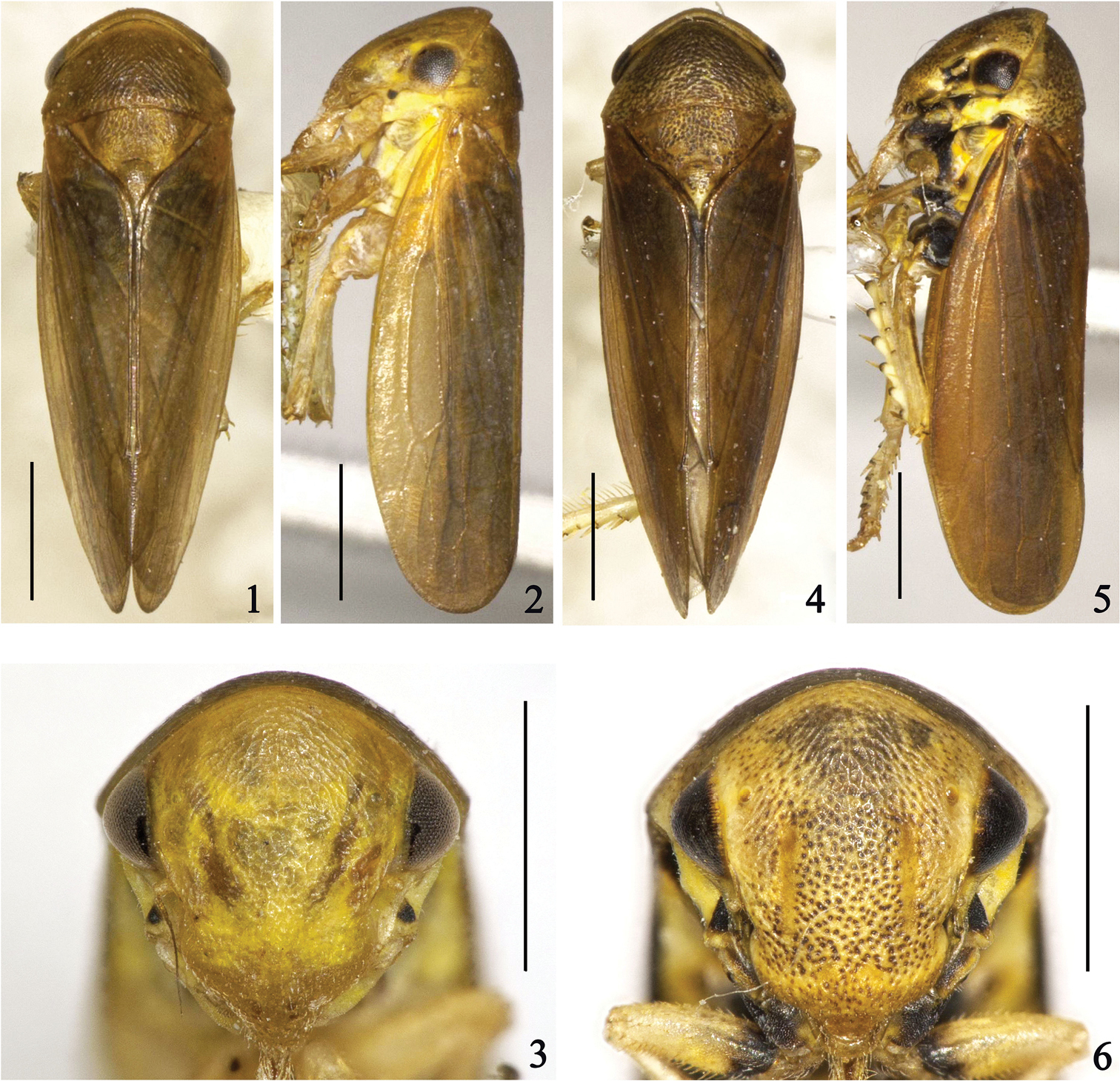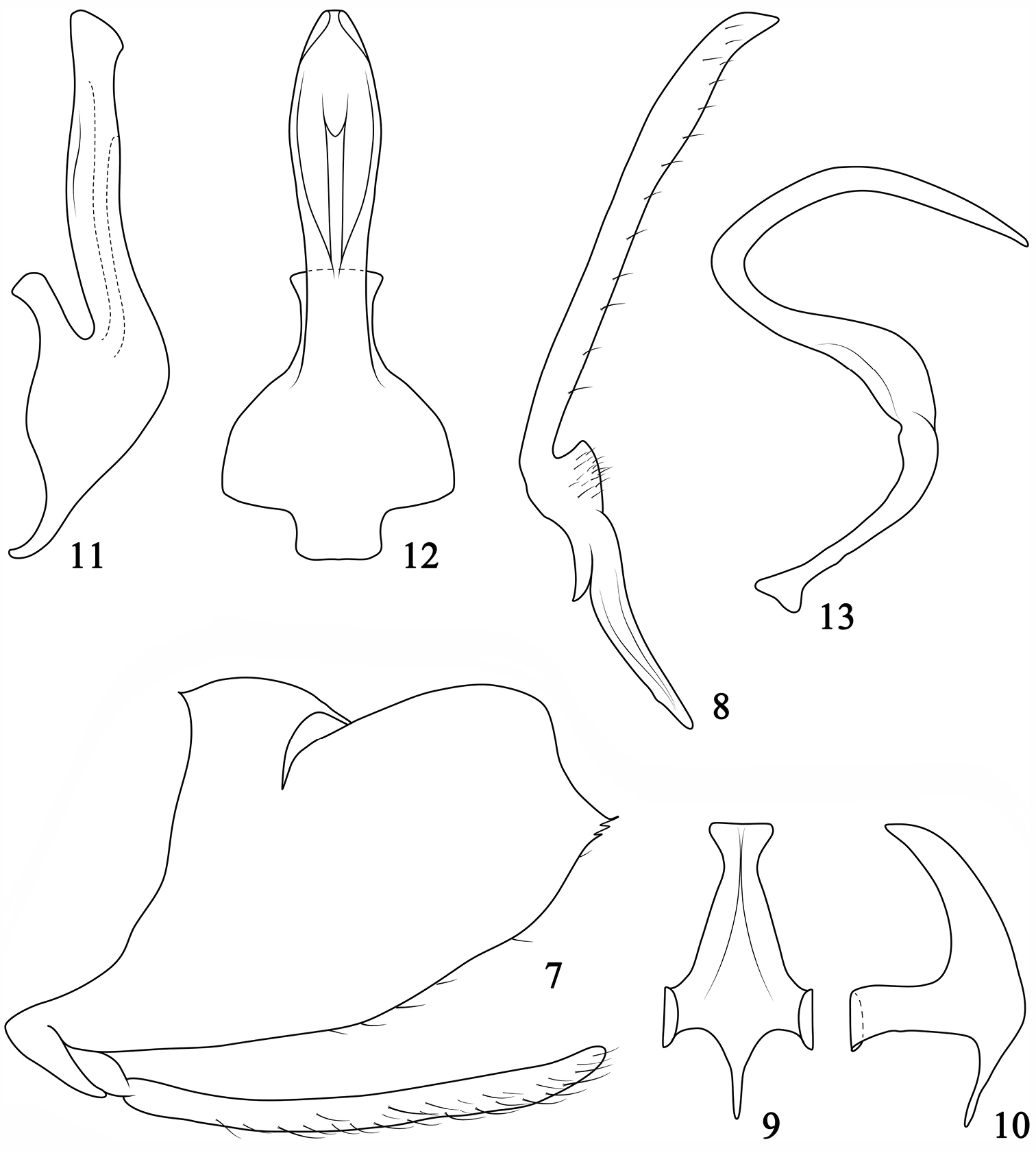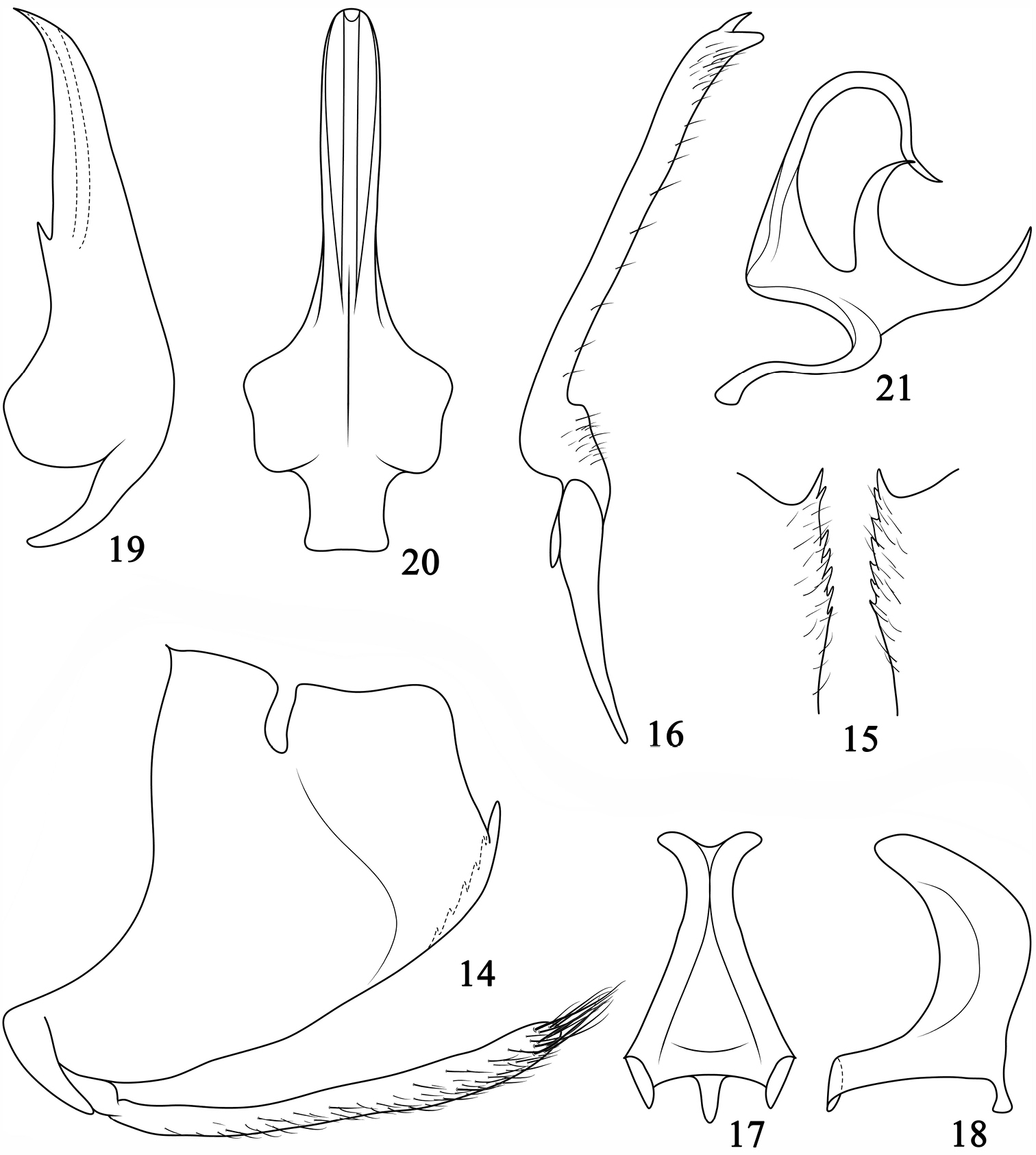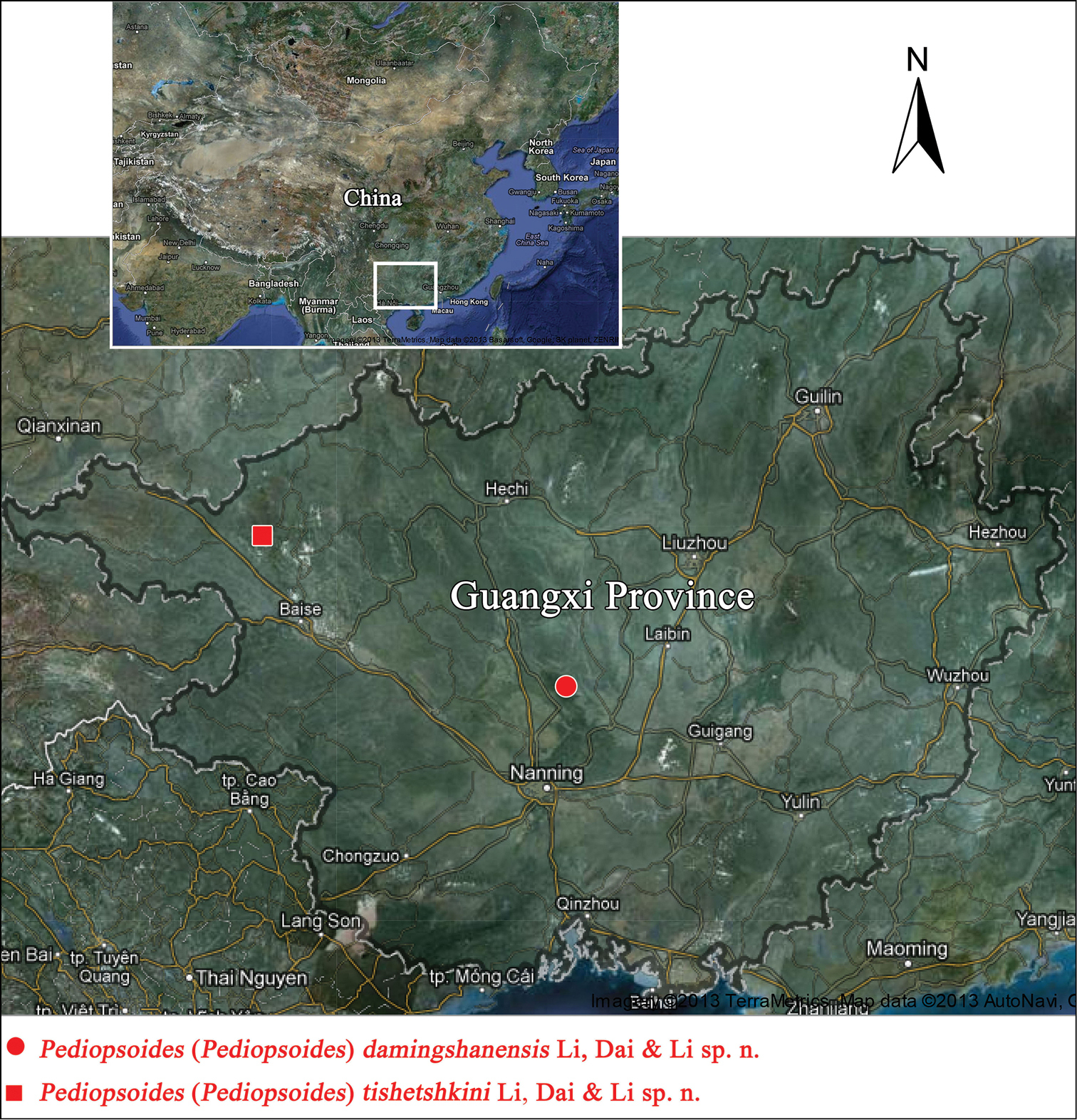






(C) 2013 Hu Li. This is an open access article distributed under the terms of the Creative Commons Attribution License 3.0 (CC-BY), which permits unrestricted use, distribution, and reproduction in any medium, provided the original author and source are credited.
For reference, use of the paginated PDF or printed version of this article is recommended.
Citation: Li H, Dai R-H, Li Z-Z (2013) Description of two new species of the leafhopper subgenus Pediopsoides (Pediopsoides) (Hemiptera, Cicadellidae, Macropsinae) from Guangxi Province, Southern China. ZooKeys 321: 15–23. doi: 10.3897/zookeys.321.5454
Two new species of the Macropsinae leafhopper subgenus Pediopsoides (Pediopsoides) Matsumura, 1912, Pediopsoides (Pediopsoides) damingshanensis Li, Dai & Li, sp. n. and Pediopsoides (Pediopsoides) tishetshkini Li, Dai & Li sp. n., are described and illustrated from Guangxi Province of southern China. A key to males is provided to distinguish the species of the subgenus along with a map showing the distribution of the new species.
Auchenorrhyncha, taxonomy, morphology, description
The leafhopper genus Pediopsoides (Insecta: Auchenorrhyncha: Membracoidea: Cicadellidae: Macropsinae) was established by
In the present paper, 2 new species, Pediopsoides (Pediopsoides) damingshanensis Li, Dai & Li sp. n. and Pediopsoides (Pediopsoides) tishetshkini Li, Dai & Li sp. n., from Guangxi province (included in the oriental region) of southern China are described and illustrated, a key to species of the nominate subgenus are provided, along with a map showing the distribution of the new species.
Terminology used in describing the structures follows
External morphology and dissected male genitalia were observed under an Olympus SZ2-ILST stereoscopic microscope and YS 100 microscope. Habitus images of adults were obtained by using a KEYENCE VHX-1000 system and were processed using the software Adobe Photoshop CS6. Hand drawings of the male genitalia were processed with Adobe Illustrator CS6. The body length is measured from the apex of the head to the apex of the forewings and are given in millimeter (mm.).
The type specimens of the new species are all deposited in the Institute of Entomology, Guizhou University, Guiyang, China (GUGC).
Pediopsoides formosanus Matsumura, 1912, by original designation.
The nominate subgenus was characterized by
Oriental region: China, Japan and India.
http://zoobank.org/8874F63A-824B-43CC-9509-F1D6180A8B5E
http://species-id.net/wiki/Pediopsoides_damingshanensis
Figures 1–3, 7–13, 22CHINA: Guangxi Province, Damingshan.
Body length (including tegmina), ♂, 4.0 mm.
Body coloration. General color (Figs 1–3) yellowish brown. Face (Fig. 3) yellowish with slight greenish tinge, eyes pale brown, slight brown oblique band adjacent inner sides of ocelli, lower part of face pale brown. Pronotum (Fig. 1) dark brown centrally, lateral and front margins gradually more yellowish. Scutellum (Fig. 1) dark brown except lateral margins yellowish. Forewings (Fig. 2) evenly dark brown except yellowish basal part. Legs pale yellowish.
External morphology. Head, face, pronotum, and scutellum faintly striated. Head (Fig. 1), in dorsal view, clearly arcuate forward, slightly narrower than pronotum, crown distinctly shorter medially than next to eyes. Face (Fig. 3), in lateral view, moderately flat; in facial view, as wide as long across eyes; dorsal part of frontoclypeus with slight medial longitudinal carina; ocelli about 9 times their diameter to adjacent eye; lacking clear sutures between lora and frontoclypeus. Pronotum (Fig. 1) 2.2 times as long as wide, frontally and laterally with oblique striations; anterior margin strongly arched, posterior margin excavate medially. Scutellum (Fig. 1) 1.3 times longer than pronotum. Forewings (Fig. 2) hyaline, with 2 anteapical cells, venation protruding. Hind femoral macrosetae 2+1; hind tibia with 7 macrosetae on AD row, 5 on AV row, 11–12 on PD row, dense and slender on PV row.
1–3 Pediopsoides (Pediopsoides) damingshanensis Li, Dai & Li sp. n. 4–6 Pediopsoides (Pediopsoides) tishetshkini Li, Dai & Li sp. n. 1, 4 Dorsal habitus, male 2, 5 Lateral habitus, male 3, 6 Face.
Male genitalia. Pygofer (Fig. 7), with dorsal margin incised, caudal margin truncate, slightly sinuated in lateral view, ventral margin serrate distally with few fine setae. Subgenital plate (Fig. 7), in lateral view, slightly shorter than pygofer, slender, rod-like, with many scattered setae. Style (Fig. 8), slender, apophysis margined with short fine setae, slightly angled after lateral lobe, slightly inflated subapically, apex subacute. Connective (Figs 9–10) distinctly longer than greatest width basally, with anterior medial process long, arms bent dorsally. Aedeagus (Figs 11–12), with short preatrium; dorsal apodeme moderately long; shaft sinuate, in lateral view apex truncate, in ventral view broad basally, widened subapically; gonopore long, apical on ventral margin. Dorsal connective (Fig. 13) “S” shaped with acute apex.
Pediopsoides (Pediopsoides) damingshanensis Li, Dai & Li sp. n. 7 Male pygofer side and subgenital plate, lateral view 8 Style, dorsal view 9 Connective, dorsal view 10 Connective, lateral view 11 Aedeagus, lateral view 12 Aedeagus, ventral view 13 Dorsal connective, lateral view.
Female. Unknown.
Holotype, ♂, CHINA: Guangxi Province, Damingshan National Natural Reserve, 14. V. 2012, collected by Li Hu.
Distribution. Guangxi Prov. (Damingshan), China (Fig. 22).
This new species differs from other members of the subgenus Pediopsoides (Pediopsoides) by the shape of the male genitalia.
The new species name refers to the type locality, Damingshan.
http://zoobank.org/9A8FCAC5-D112-43BC-A401-367DCDCE83E9
http://species-id.net/wiki/Pediopsoides_tishetshkini
Figures 4–6, 14–22CHINA: Guangxi Province, Tianlin.
Body length (including tegmina), ♂, 4.5 mm.
Body coloration. Color (Figs 4–6) similar to Pediopsoides (Pediopsoides) damingshanensis but darker; with large black spot adjacent antennal pit and basal parts of fore femur and coxa, middle and hind coxa marked with dark brown.
External morphology. As in Pediopsoides (Pediopsoides) damingshanensis but head more narrower than pronotum and crown more arcuate forward; face (Fig. 6), in lateral view, slightly inflated; ocelli with their spacing about 8 times than that of ocellus to adjacent eye; scutellum (Fig. 4) about 1.4 times longer than pronotum. Hind femoral macrosetae 2+1; hind tibia with 7 macrosetae on AD row, 6 on AV row, 11 on PD row, dense and slender on PV row.
Male genitalia. Similar to Pediopsoides (Pediopsoides) damingshanensis but pygofer (Fig. 14) shorter, style (Fig. 16) with lateral lobe shorter and apex bearing a spine-like process and connective (Figs 17–18) more robust in lateral view. Aedeagus (Figs 19–20) with basal apodeme reduced; preatrium moderately long; shaft in lateral view relatively straight, evenly tapered to sharply pointed and upturned apex; in ventral view shaft similar in width throughout length with rounded apex; gonopore apical on ventral margin. Dorsal connective (Fig. 21) strongly developed “S” shaped, medially produced into bifurcate process, two dorsal branches widely spaced and tapered to acute apex.
Pediopsoides (Pediopsoides) tishetshkini Li, Dai & Li sp. n. 14 Male pygofer side and subgenital plate, lateral view 15 Ventral margins of male pygofer 16 Style, dorsal view 17 Connective, dorsal view 18 Connective, lateral view 19 Aedeagus, lateral view 20 Aedeagus, ventral view 21 Dorsal connective, lateral view.
Female. Unknown.
Holotype, ♂, CHINA: Guangxi Province, Baise City, Tianlin County, Langping Village, 23. IV. 2012, collected by Zheng Weibin.
Guangxi Prov. (Tianlin), China (Fig. 22).
Map showing the distribution of Pediopsoides (Pediopsoides) damingshanensis Li, Dai & Li sp. n.and Pediopsoides (Pediopsoides) tishetshkini Li, Dai & Li sp. n.
The new species is similar to Pediopsoides (Pediopsoides) damingshanensis sp. n. but can be distinguished by its darker colour and differences in the male genitalia (see description).
This species is named in honour of Dr. Dmitri Yu. Tishechkin for his excellent contribution to Macropsis systematics of the Palaearctic region, and invaluable help to the first author.
Male Pediopsoides (Pediopsoides) formosanus (Matsumura) is not known, hence not included in the key. The present key is modified from
| 1 | Aedeagal shaft with processes | 2 |
| – | Aedeagal shaft without processes (Figs 11–12, 19–20) | 4 |
| 2 | Aedeagal shaft with apical processes laterally directed and on either side of gonopore | Pediopsoides (Pediopsoides) jingdongensis Zhang |
| – | Aedeagal shaft with subapical processes directed dorsally or ventrally | 3 |
| 3 | Aedeagal shaft processes directed dorsally | Pediopsoides (Pediopsoides) kodaiana Viraktamath |
| – | Aedeagal shaft processes directed ventrally | Pediopsoides (Pediopsoides) femorata (Hamilton) |
| 4 | Aedeagal shaft inflated subapically in lateral view | Pediopsoides (Pediopsoides) satsumensis (Matsumura) |
| – | Aedeagal shaft either of uniform width (Fig. 11) or narrowed subapically (Fig. 19) | 5 |
| 5 | Clypellus black | Pediopsoides (Pediopsoides) nigorolabium Li, Dai & Li |
| – | Clypellus not black | 6 |
| 6 | Aedeagal shaft of uniform width in lateral view (Fig. 11); dorsal connective S-shaped (Fig. 13) | Pediopsoides (Pediopsoides) dainghanensis Li, Dai & Li sp. n. |
| – | Aedeagal shaft tapered variously distally (Fig. 19) | 7 |
| 7 | Style with subapical tooth-like process (Fig. 16) | Pediopsoides (Pediopsoides) tishetshkini Li, Dai & Li sp. n. |
| – | Style without a subapical tooth-like process | Pediopsoides (Pediopsoides) bispinata Li, Dai & Li |
The authors thank Zheng Wei-Bin (Institute of Entomology, Guizhou University, Guiyang, Guizhou, China) for providing material studied. This project was supported by the National Natural Science Foundation of China (31000952).



